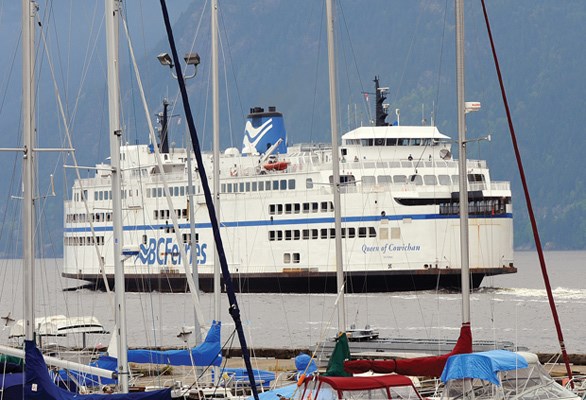B.C. Ferries is considering major changes to service between Vancouver Island and the mainland, including closing one Nanaimo terminal and funnelling mainland-bound traffic through Tsawwassen instead of Horseshoe Bay.
The proposals are part of a massive rethink of B.C. Ferries’ mid-Island service, in an attempt to drive down billions in new capital costs and slow the rise of ticket prices.
They were outlined in an “efficiency plan” quietly posted to the independent ferry commissioner’s website last month and confirmed by the ferry corporation and government on Tuesday.
No final decisions have been made, but Transportation Minister Todd Stone said Tuesday that B.C. Ferries is analyzing scenarios with the goal of public consultation in mid-2015 and final decisions by the end of that year.
“It’s plausible to consider a scenario in the not-too-distant future whereby the vast majority of traffic from Nanaimo could potentially go through Tsawwassen,” Stone said in an interview.
It’s the first time B.C. Ferries has openly floated an overhaul of its profitable major routes between the Vancouver area and Vancouver Island, which account for 80 per cent of its revenue and subsidize the money-losing minor routes.
Key to the discussion is $200 million in upgrades B.C. Ferries says are required to Horseshoe Bay’s transfer decks. It’s the biggest non-vessel expense in a capital plan of almost $3 billion over the next 10 to 12 years, and Stone said he has challenged B.C. Ferries on whether it’s necessary.
“What I’ve said to [B.C. Ferries CEO] Mike Corrigan and the folks at B.C. Ferries is now is the time to take a look at whether or not we continue to require two terminals in Nanaimo or could those two terminals be consolidated into one terminal, perhaps at Duke Point,” Stone said.
Even if Nanaimo traffic shifted from Horseshoe Bay to Tsawwassen, there would still need to be a terminal at Horseshoe Bay to service the Bowen Island and Sunshine Coast routes, Corrigan said. “There’s no scenario where a Horseshoe Bay terminal won’t be there,” Corrigan said in an interview.
There’s also the possibility of looking at passenger-only service from the Island, he said.
The Horseshoe Bay terminal is hamstrung because of congestion in the harbour, topographical challenges, scheduling problems, limited terminal space, vehicle-traffic backlogs and “significantly higher risk” that any construction would blow the $200-million budget, says the efficiency report.
The new 40-kilometre South Fraser Perimeter Road, which links the Tsawwassen terminal to north Surrey, has improved the potential for more Island traffic to land at Tsawwassen, said B.C. Ferries and Stone.
The report lists numerous ideas, such as buying fewer vessels, changing routes and overhauling the reservation system in a bid to save millions of dollars over the next 10 to 20 years. The overhaul would allow customers to purchase tickets for specific sailings in advance, enabling the ferry corporation to better plan for demand.
Most changes would require Stone’s approval. He said he’s pleased B.C. Ferries is undertaking detailed analysis.
“The decisions we make in the coming months related to Nanaimo and Horseshoe Bay will go a long way to helping us achieve our goal of getting fare increases tied to inflation,” he said.



